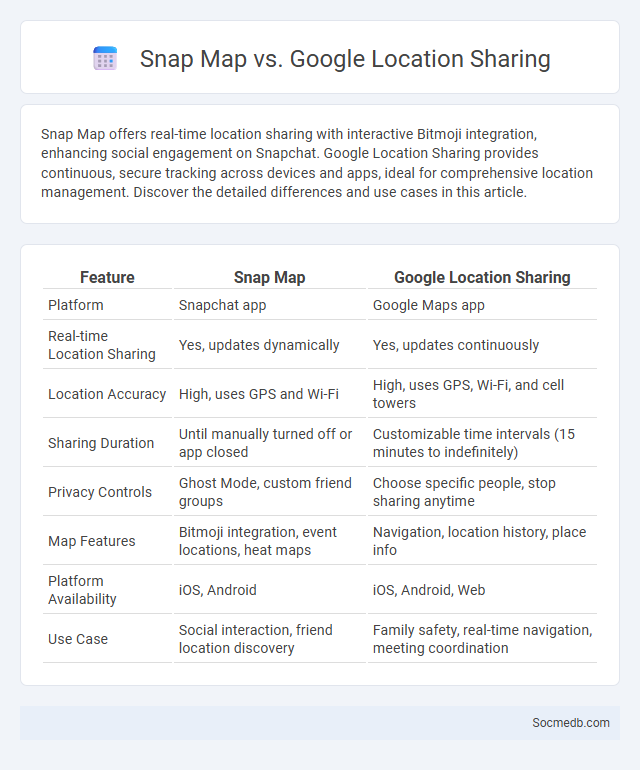
Photo illustration: Snap Map vs Google Location Sharing
Snap Map offers real-time location sharing with interactive Bitmoji integration, enhancing social engagement on Snapchat. Google Location Sharing provides continuous, secure tracking across devices and apps, ideal for comprehensive location management. Discover the detailed differences and use cases in this article.
Table of Comparison
| Feature | Snap Map | Google Location Sharing |
|---|---|---|
| Platform | Snapchat app | Google Maps app |
| Real-time Location Sharing | Yes, updates dynamically | Yes, updates continuously |
| Location Accuracy | High, uses GPS and Wi-Fi | High, uses GPS, Wi-Fi, and cell towers |
| Sharing Duration | Until manually turned off or app closed | Customizable time intervals (15 minutes to indefinitely) |
| Privacy Controls | Ghost Mode, custom friend groups | Choose specific people, stop sharing anytime |
| Map Features | Bitmoji integration, event locations, heat maps | Navigation, location history, place info |
| Platform Availability | iOS, Android | iOS, Android, Web |
| Use Case | Social interaction, friend location discovery | Family safety, real-time navigation, meeting coordination |
Introduction to Location Sharing Technologies
Location sharing technologies utilize GPS, Wi-Fi, and cellular data to pinpoint your real-time position on social media platforms. These systems enhance user interaction by enabling geo-tagged posts, check-ins, and localized content delivery. Understanding how your location data is collected and shared is crucial for managing privacy and optimizing your social networking experience.
Snap Map Overview: Features and Functionality
Snap Map allows you to share your real-time location with friends on an interactive map while controlling privacy settings for visibility. Key features include location sharing, event heat maps, and the ability to explore popular snaps from around the world. This functionality enables you to stay connected and discover trends through visual updates directly integrated within Snapchat.
Google Location Sharing: Key Benefits and Uses
Google Location Sharing offers real-time location tracking that enhances safety by allowing users to share their whereabouts with trusted contacts. It facilitates seamless coordination for group events and improves logistics planning by providing accurate, up-to-date location data. Businesses leverage this feature to optimize delivery routes and monitor field staff efficiency, driving operational productivity.
Snap Map vs Google Location Sharing: Core Differences
Snap Map offers real-time location sharing within Snapchat, emphasizing social interaction and spontaneous updates, while Google Location Sharing provides continuous, precise location tracking across multiple devices and platforms for practical use. Your choice depends on whether you prefer a fun, ephemeral way to connect with friends or a reliable tool for consistent location monitoring. Privacy controls differ, with Snap Map limiting visibility to Snapchat friends and Google allowing customizable sharing with selected contacts.
Privacy and Security Comparison
Social media platforms vary significantly in privacy and security features, with end-to-end encryption available on services like WhatsApp and Signal, offering robust protection against unauthorized access. Facebook and Instagram have faced scrutiny over data breaches and user data handling, raising concerns about personal information exposure. Users prioritizing privacy should evaluate platform policies on data encryption, third-party sharing, and user controls to mitigate risks effectively.
User Experience and Interface Design
User experience (UX) in social media platforms emphasizes intuitive navigation, fast load times, and personalized content feeds to enhance user engagement. Interface design prioritizes clear visual hierarchy, accessible features, and adaptive layouts for seamless interaction across devices. Effective integration of microinteractions and minimalistic design elements reduces cognitive load, fostering prolonged user retention and satisfaction.
Integration with Social Platforms
Seamless integration with social platforms enhances your brand visibility and boosts user engagement by enabling direct sharing, real-time interactions, and unified content management across channels like Facebook, Instagram, and Twitter. Leveraging APIs and social media management tools streamlines scheduling, analytics, and customer interaction, ensuring consistent messaging and improved marketing effectiveness. Optimizing integration strategies increases your reach and drives targeted traffic, significantly impacting conversion rates and overall digital presence.
Real-Time Location Accuracy
Real-time location accuracy on social media platforms enhances user engagement by enabling precise geotagging and location-based interactions. Advanced GPS technologies and AI-driven algorithms improve the fidelity of location data, supporting features such as location-specific content delivery and emergency response. High location accuracy fosters personalized experiences, increasing the relevance of advertisements and local recommendations.
Customization and Control Options
Social media platforms offer extensive customization and control options allowing users to tailor their feed, privacy settings, and notification preferences to enhance user experience. Advanced algorithms enable personalized content curation based on user behavior, interests, and interaction history, improving engagement and relevance. Privacy control tools empower users to manage data sharing, block unwanted interactions, and set visibility levels for posts and profiles, ensuring a secure and user-centric environment.
Choosing the Best Location Sharing App: Final Verdict
Choosing the best location sharing app depends on your privacy needs, ease of use, and compatibility with your devices. Apps like Life360 offer comprehensive family tracking features, while WhatsApp provides simple location sharing within chats, balancing convenience with security. Your decision should consider app permissions, real-time accuracy, and integration with existing social media platforms for seamless sharing.
 socmedb.com
socmedb.com